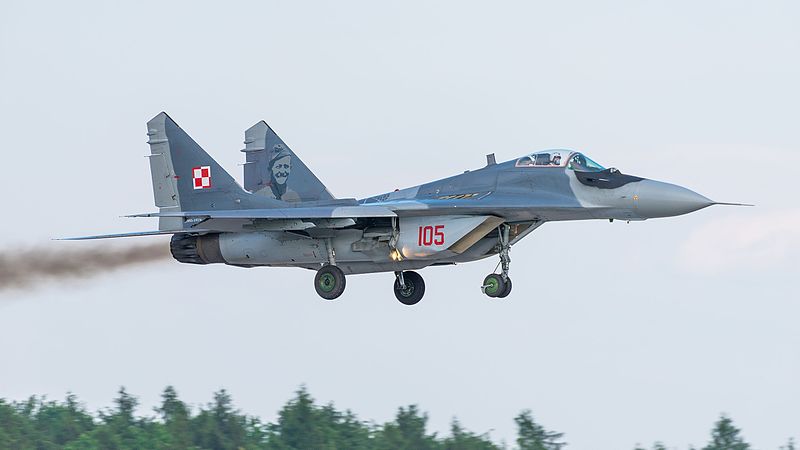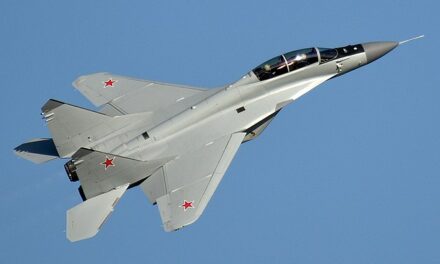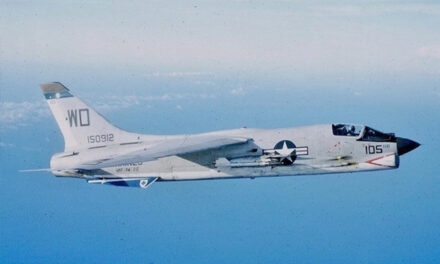MiG-29 Fulcrum
The Mikoyan MiG-29 is fighter aircraft with a twin-engine designed for the role air superiority fighter, and multirole fighter in the former Soviet Union, today Russia. MIG-29 original name is ” Микоян МиГ-29″ on Russian, NATO reporting name for this aircraft is Fulcrum. MIG is short for Mikoyan and Gurevich Design Bureau, today Mikoyan design bureau (Mikoyan OKB). Also, MIG on Russian mean blink of an eye and is a synonym for speed.
MIG-29 Fulcrum was developed by the Mikoyan OKB in 1974. MIG-29 first flight taking place on 6 October 1977 designated as MiG-29A (Mikoyan Product 9). MiG-29 was developed to counter the new U.S. fighters F-16 Fighting Falcon and F-15 Eagle. The MiG-29 entered service with the Soviet Air Forces in July 1982 and still is in service in Russia and more than 25 countries. (MIG-29 variants).
The project was underway from 1974-1977 and because of the revolutionary design of airframe, engines, and systems 19 prototypes were built including two-seaters. The design was very different from the previous MIG aircraft. Prototypes were numbered 9-01 to 9-19, numbers 01-19 begin painted on the air intakes. The second and fourth prototype (both single-seaters) were testbeds for engines and were lost without loss of a pilot’s life. The second is lost on 15th June 1978, and the fourth is lost on 31st October 1980. MIG-29 number 9-03 was a two-seater prototype for the MIG-29UB trainer. All prototypes flew approximately two thousand sorties during tests.
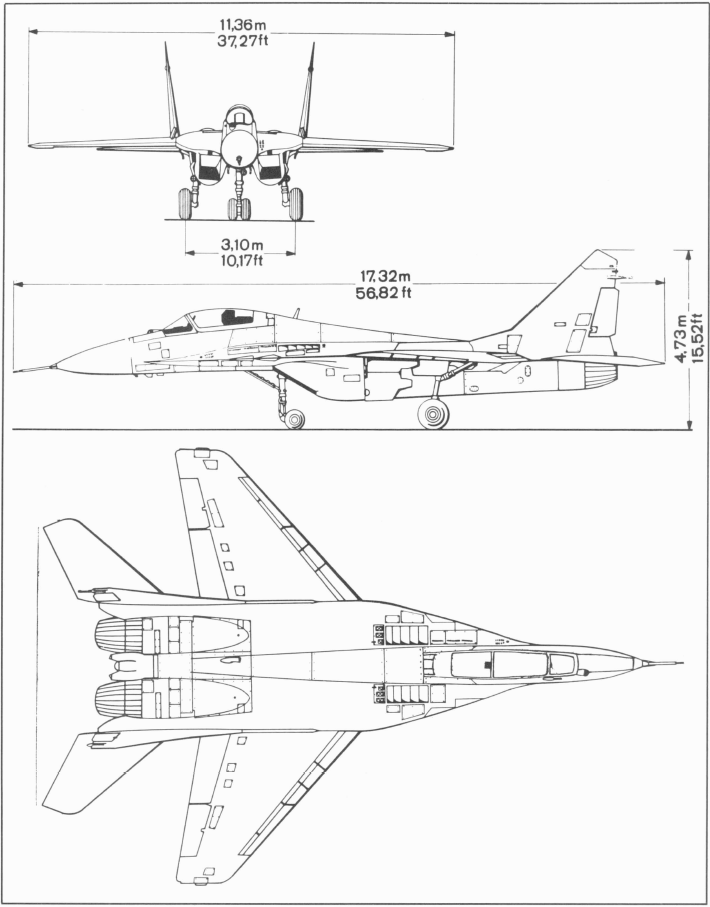
MIG-29 Development
In the late 1960s, Mikoyan OKB began working on their first studies of a new generation “lightweight” fighter with performances close to its overseas counterparts (F-15, F-16, and YF-17, later F/A-18), which were very near to the prototype stage. The designs resulted in developing a new fighter with outstanding maneuverability and high thrust-to-weight ratio for close air combat in the frontline area, including an interception of enemy cruise missiles. The secondary air-to-ground attack capability required an ability to carry bombs, internal guns, or FFAR rockets for delivery under VFR conditions. Under the leadership of R. A. Belyakov, several designs based on specifications calling for a new LPFI fighter were made in Mikoyan OKB. All designs have a twin-engine configuration. One of the projects was similar to the MiG-25 Foxbat with large rectangular side air intakes. The result was very different from previous MiG fighters. The project received the designation MiG-29 (in the OKB it was so-called “program 9” or “Product 9”). It was based on up-to-date aerodynamic studies and the airframe configuration was similar to General Dynamic F-16A.
Engines were housed in two separate gondolas under the rear part of the fuselage. About 40% of the lift was developed by a wide “lifting” fuselage with a large LERX. This design allows for outstanding maneuverability and good AoA performance. MIG-29 in close combat can outmaneuver any western fighter. This is proven by German MIG-29 pilots after the German reunification in October 1990. New engines gave a thrust-to-weight ratio of 1.09, never reached by former MiG fighters. The first prototype was flown on 6th October 1977, with A. V. Fedotov as a pilot. In the case of the MiG-29, the Soviets held off the public display and it was some nine years from the maiden flight of the MiG-29 until its official unveiling. Unlike earlier MiG designs, the Soviets kept the MiG-29 project under strict security throughout the flight test program. The Soviets had kept the Fulcrum hidden from Western observers longer than any other type built in Soviet history.
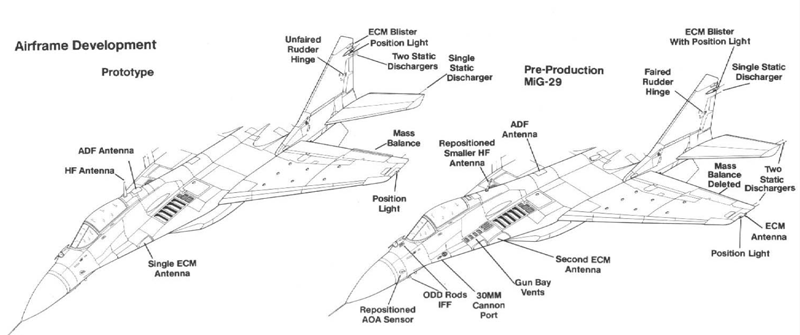
The preproduction aircraft differed from the prototypes in a number of ways. A single GSh-301 30mm cannon was installed in the port wing root and six underwing weapons pylons. The aircraft was fitted with Odd Rods IFF antennas mounted above and below the nose. At least three preproduction MiG-29’s were lost during the tests. The MiG-29 is the first Soviet aircraft to be equipped with a look-down/shoot-down radar system. This means that the aircraft’s radar can track and engage targets, such as aircraft or cruise missiles, flying below the fighter’s own altitude.
MIG-29 Power Plant
The MiG-29 has two widely spaced Klimov RD-33 turbofan engines. Each engine rated at 50.0 kN (11,240 lbf) dry and 81.3 kN (18,277 lbf) in afterburner. The space between the engines generates lift, thereby reducing effective wing loading, hence improving maneuverability. As we said before, 40% of the lift was developed by a wide “lifting” fuselage with a large LERX. Early production RD-33 engines had poor overhaul (TBO) limits, but were improved on the production line. Although the RD-33 power plant initially gave the designers a lot of problems, the engine has evolved into a very reliable power plant. The power plant has very low fuel consumption, comparable to most advanced Western engines.
- Range: 1,430 km (890 mi, 770 nmi) with maximum internal fuel
- Ferry range: 2,100 km (1,300 mi, 1,100 nmi) with 1x drop tank
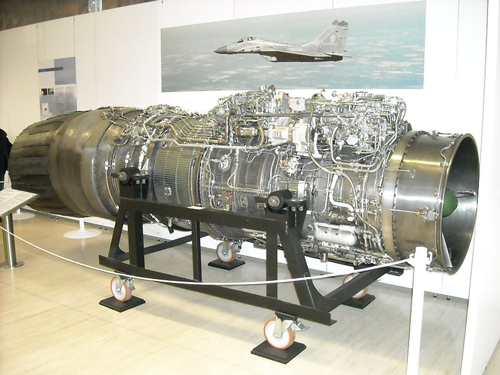
MIG-29 Cockpit
The cockpit features a conventional center stick and left-hand throttle controls. The pilot sits in a Zvezda K-36DM ejection seat which has had an impressive performance in emergency escapes. One of the most impressive innovations used with the MiG-29 is the helmet-mounted sight. Shchel-3UM is World’s first helmet-mounted display. It essentially gives the aircraft an “off-boresight” targeting capability, as it allows the pilot to look and engage a moving target beyond the boundaries of the HUD (Heads Up Display). This SUV Gunsight (SUV is short for a fire-control system ) is on a rail attached to the pilot’s helmet. As the pilot turns his head to visually follow the target. This motion is transmitted to the weapons system, pointing the missile seeker head in the direction of the target. The SUV system can also be used to control and direct the entire aircraft. Set in the pilot-mode the SUV directs the aircraft to follow the motion of the pilot’s eyes. If the pilot looks right and down, the aircraft turns right and down.
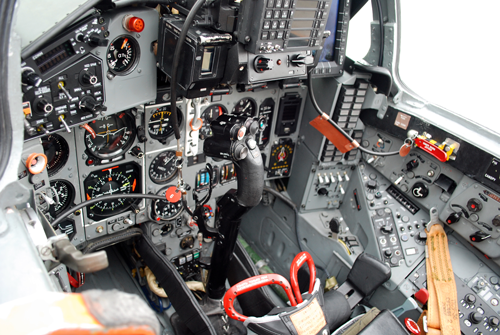
MIG-29 Armament
One single-barrelled GSh-301 (9A4071K) 30 mm cannon (initial muzzle velocity 860 ms1, 150 rounds in ammo box) is the only in-built weapon. The cannon can’t be fired when the underbelly auxiliary fuel tank is attached. This was corrected in the MiG-29S and later versions. This gun originally had a 150-round magazine, which was reduced to 100 rounds in later variants. Three pylons are provided under each wing (four in some variants), for a total of six. The inboard pylons can carry either a 1,150 liter (300 US gal) fuel tank, one Vympel R-27 (AA-10 “Alamo”) medium-range air-to-air missile, or unguided bombs or rockets. The outer pylons usually carry R-73 (AA-11 “Archer”) dogfight air to air missiles, although some users still retain the older R-60 (AA-8 “Aphid”). A single 1,500-litre (400 US gal) tank can be fitted to the centerline, between the engines. Some Soviet aircraft could carry a single nuclear bomb on the port inboard station.
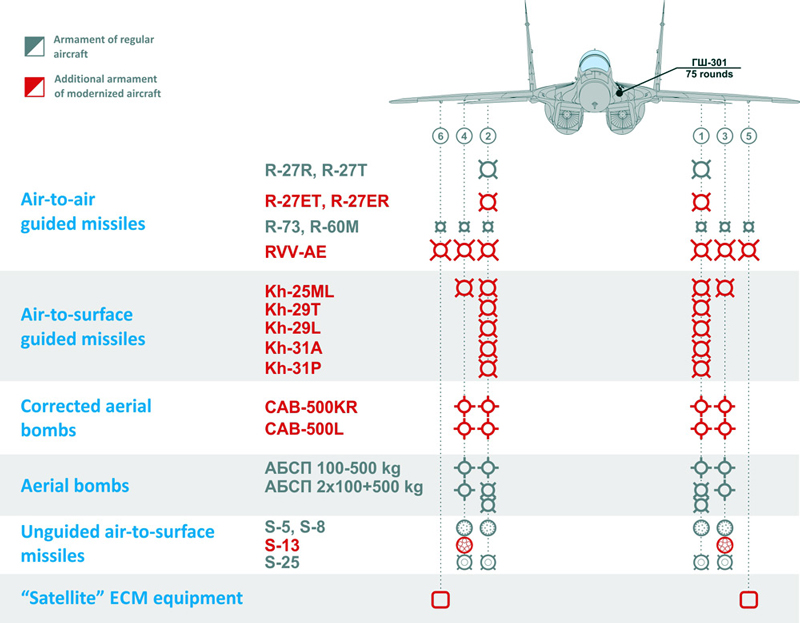
MIG-29 Variants
MIG-29 Fulcrum A ( 9-12 )
MIG-29 Fulcrum A – (product “9-12”) is the initial production-standard for a single seat counter-air fighter, with the visual ground-attack capability. MIG-29 designated 9-12 is the first single-seater production fighter, produced in quantity. The MiG-29 was designated 9-12 for the Soviet Union, 9-12A for Warsaw Pact air forces, and 9-12B for export customers.
Experiences in pre-production models, service, and development resulted in modification, most of the refinements were later retrofitted during repairs to or maintenance of early series aircraft. Therefore, now it is difficult to recognize aircraft from different batches. The main difference from prototypes was the introduction of the K-36DM ejection seat with associated changes in the cockpit canopy outline.
The MiG-29 Fulcrum A is a single-seat twin-engined all-weather tactical fighter. It has secondary air-to-ground capability limited to staffing, bombing, and firing FFAR roc kets at VFR conditions. It is a high-wing monoplane with medium angle swept wing, LERX, and wide fuselage designed to produce 40% of the lift. It has two fins and rudders and a stabilizer used for pitch and roll control. Two RD-33 turbofans from Klimov OKB are located in separate engine gondolas under the fuselage. The construction is from duralumin, light alloys, titanium, steel, and some carbon composites and honeycomb.
Several parts of the airframe, produced from carbon composite, changed to conventional duralumin due to poor production quality of the advanced material. Avionic components were also changed as a result of development and upgrading and (in case of export deliveries to other Warsaw Pact countries) according to the user’s requirements. These changes are often apparent in the cockpit interior and externally in the different aerial system. The export variant for Warsaw Pact countries was called 9-12A, for other users 9-12B. This model is the downgraded export version for non-Warsaw Pact nations. 9-12A lacks a nuclear weapon delivery system and has initial production radar, ECM, and IFF. Model 9-12B does not have ECM and IFF.
The main radar of the MiG-29 is the RP-29 or S-29, also designated N019 (NATO reporting name Slot Back), developed by Fazotron, forming the main element in the RLPK-29 radar aiming kompleks. Later production aircraft have the RP-29E (E for export). Together with the Ts100.02.06 digital computer, this forms the RLPK-29E radar-aiming kompleks. The S-29 is a typical pulse-doppler set of the 1970s, without any ground mapping modes but able to track ten aerial targets simultaneously and guide semi-active missiles. It has a twisted-Cassegrain antenna, scanned mechanically over limits of ±67° in azimuth, and +60°/-38° vertically. Fazotron describes the detection range against fighter-type targets as 100km (62 miles), hut pilots of customer air forces have often said I he achieved range can be much greater. The tracking range is officially 70km (43 miles). Later VliG-29 variants have radars of greater power, matched to longer-ranged R-27 missiles.
The aircraft’s fire control system is automated and capable of tracking ten targets at once. Once the target is within range, the weapons system will automatically select and launch a suitable missile. A comparison flight between a MiG-29 and F-16 ware conducted in Germany. The test revealed that the 01-93 radar detected the F-16 earlier than the F-16’s radar acquired the MiG-29.
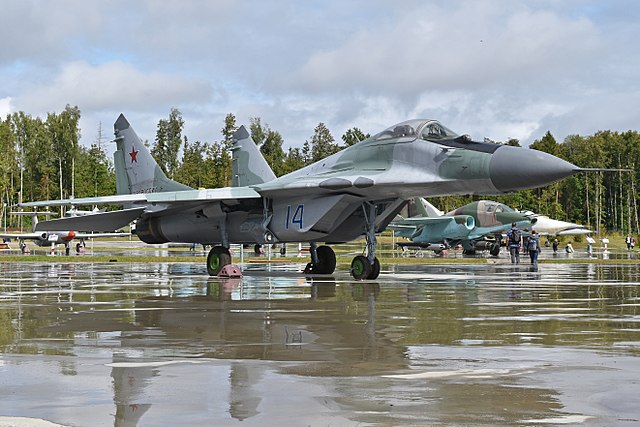
The various sensors, radar, infrared search/track (IRST), and laser ranging (LR) can ail be used individually but are usually linked via the fire control computer to the Head-Up Display (HUD). The IRST automatically locks on to any heat source within its field of view and the radar can be fed information from the IRST in the form of a false echo to allow- the Fulcrum to make a non-emitting approach to the target. If the IRST/LR is blinded by the cloud, the radar automatically switches to transmit. The radar is aligned automatically with the IRST (even when in standby) so that the target is kept within the radar’s field of view.
Although the MiG-29 was never deployed to Afghanistan for a combat evaluation as did many Sukhoi Su-25 prototypes/pre-production aircraft, the war had a direct influence on the future modification to the basic MiG-29. Throughout its production life, the MiG-29 was continually changed and improved. Up to 1990, some 800 MiG-29s had been built, with the majority being delivered to Frontal Aviation Regiments, although there are at least fifty aircraft known to be assigned to the Air Defense Forces (PVO) and 250 aircraft have been exported.
The MiG-29 can carry a large variety of weapons. For its primary role of air-to-air combat the usual configuration consists of two R-27 s (A A-10 Alamo), R-73s (AA-11 Archer), and R-60s (AA-8 Aphid), three missiles under each. The MiG-29 can also carry the older R-23 (AA-7 Apex) missile. Because of its weight [400 pounds), the R- 27 is only carried on the inboard pylon.
For its secondary mission of ground attack the Fulcrum can carry UB-32-57 rocket pods, each with thirty-two type S-5 57mm rockets or B-8MI rocket pods with the larger S-8 lS-8K) unguided rockets. For ferry flights, the Fulcrum can carry an external fuel tank mounted between the engine nacelles. One of the most impressive innovations used with the MiG-29 is the helmet-mounted sight. Another warning system installed in the aircraft is an acoustical warning system that provides the pilot information on possible threats or other dangers. A passive radar warning sensor system {NATO reporting name Syrena 3) is fitted to the MiG-29. System receivers are mounted at various points on the fuselage giving the Fulcrum 360 degree coverage. Threat information is passed to the pilot via popular called Natasha and simultaneously displayed on the instrument panel display. The Syrena 3 also informs the pilot if a missile has been launched against him and activates the aircraft’s defenses such as the chaff/flare dispenser. The MiG-29 also has a computerized self-test system to ease maintenance, called the EKRAN device. The EKRAN system performs various automatic checks of the entire aircraft system.
MIG-29 Specifications
- Crew: 1
- Length: 17.32 m (56 ft 10 in)
- Wingspan: 11.36 m (37 ft 3 in)
- Height: 4.73 m (15 ft 6 in)
- Wing area: 38 m2 (410 sq ft)
- Empty weight: 11,000 kg (24,251 lb)
- Gross weight: 14,900 kg (32,849 lb)
- Max takeoff weight: 18,000 kg (39,683 lb)
- Fuel capacity: 3,500 kg (7,716 lb) internal
- Powerplant: 2 × Klimov RD-33 afterburning turbofan engines, 81.59 kN (18,340 lbf) with afterburner
Performance
- Maximum speed: 2,400 km/h (1,500 mph, 1,300 kn) at high altitude
- Maximum speed: Mach 2.25
- Range: 1,430 km (890 mi, 770 nmi) with maximum internal fuel
- Ferry range: 2,100 km (1,300 mi, 1,100 nmi) with 1x drop tank
- Service ceiling: 18,000 m (59,000 ft)
- g limits: +9
- Rate of climb: 330 m/s (65,000 ft/min)
- Wing loading: 403 kg/m2 (83 lb/sq ft)
- Thrust/weight: 1.09
Armament
- Guns: 1 × 30 mm Gryazev-Shipunov GSh-30-1 autocannon with 150 rounds
- Hardpoints: 7 × hardpoints (6 × underwing, 1 × fuselage) with a capacity of up to 4,000 kg (8,800 lb) of stores,with provisions to carry combinations of:
- Rockets:
- S-5
- S-8
- S-24
- Missiles:
- 2 × R-27R/ER/T/ET/P air-to-air missiles
- 4 × R-60 AAMs
- 4 × R-73 AAMs
- Astra (Indian Air Force)
- Bombs: 6 × 665 kg (1,466 lb) bombs
Avionics
- OEPS-29 IRST
- Phazotron Zhuk-ME radar
- SPO-15 ‘Beryoza’ RWR
MIG-29UB Fulcrum B ( 9-51 )
Mikoyan OKB planned several two-seat versions, but the first variant to follow the basic MiG-29 was the MiG-29UB (trainer for combat). MIG-29UB is a two-seater training version of MIG-29 Fulcrum A. On this model only infra-red sensors are mounted, without radar. NATO reporting code is for MIG-19UB is “Fulcrum B”. The export variant had downgraded systems similar to MiG-29 9-12. MIG-29UB is the advanced two-seater trainer with limited combat capability. The prototype was first flown on 29th April 1981 with A. Fedotov as a pilot. Production has begun in 1982 at the Gorkiy factory, now MAPO Nizhniy-Novgorod. The airframe is about 100 mm longer than the single-seater fighter MIG-29A, an instructor’s cockpit partially occupying the front fuel tank space, resulting in the trainer’s slightly downgraded fuel capacity. The periscope (mirror) on the cockpit canopy improves the instructor’s forward visibility during takeoff, approach, and landing. Because the second seat (both are of K-36DM type) is only slightly higher than the forward one. The instructor can simulate weapon control system operation (including radar) and also several failures and warning situations from his cockpit. The front cockpit is practically identical to the single-seaters. Radar was limited due to weight limits, but the other parts of the weapon system remain. The aircraft can carry and fire all weapons as single-seater except R-27 (AA-10 Alamo) missiles.
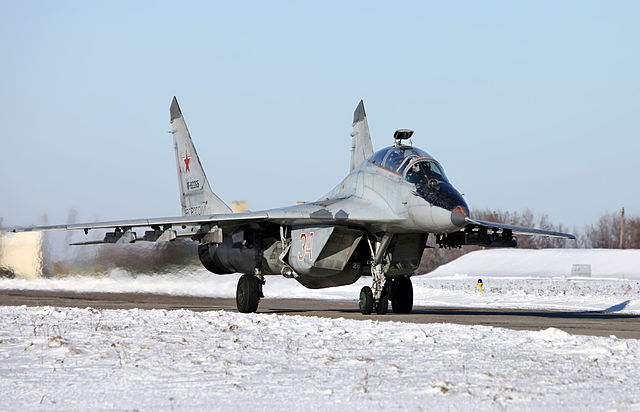
MIG-29 Fulcrum (9-13)
The MiG-29 9-13 is an upgraded variant based on the original airframe. This model features flight control system improvements.
With this designation, a number of MiG-29s were produced in the period from 1982-1991 with a slightly enlarged dorsal spine. This provided an increased internal fuel capacity, as well as room for the Gardeniya (gardenia) EGM installation. For this reason, later modification of MIG-29S gets the nickname “Fatback”. The inboard pylons can carry jettisonable auxiliary 1.130-liter fuel tanks and external load capacity has been increasing up to 4.000 kg.
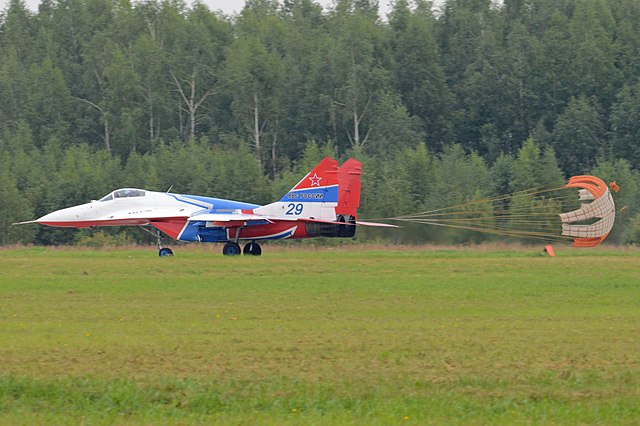
MIG-29s Fulcrum C
The MiG-29S is an upgraded variant based on the original airframe of MIG-29 Fulcrum A. NATO reporting code is “Fulcrum-C”. As the first upgrade, this basic designation covers six distinct production versions. These are 1) MiG-29S 9-12S, 2) MIG-29SD 9-12SD, 3) MiG-29SE, 9-12SE, 4) MiG-29S 9-13S, 5) MiG 29SE 9-13SE, and 6) MiG-29SM 9-12SM. All versions have the inboard underwing pylons plumbed for 800lit (176gal) or 1, 1,150lit (253gal) drop tanks. The 9-12 versions (except in the first examples) also have fuselage Tank 1 increased in capacity to 780 liters (17l.6gal), The 9-13 versions have a bulged spine and still greater capacity. MIG-29S is built only for domestic use.
MIG-29S, 9-12S
MIG-29S, 9-12S version, for the Soviet Union and Warsaw Pact customers only, was fitted with the RLPK-29M radar-aiming kompleks incorporating the N019M Topaz radar. Unlike the N019, this has a mechanically scanned slotted flat plate antenna and can engage two aerial targets simultaneously. Against fighter-type targets, Fazotron quote an effective tracking range of 75km (47 miles) with a sky background, or 65km (40 miles) against the ground, or 35km (22 miles) against a low-level target from astern. This radar also offers a ground-mapping mode and is compatible with all MiG-29 missiles, including the R-27T1, RE1, and TE1 which cannot be filed by the MiG-29. It is also compatible with the R-77 (RVV-AE), which has its own active seeker. The digital computer in the radar-aiming kompleks is the Ts101M, with enhanced memory and improved software to counter hostile jamming. Improvements to software and processing capabilities enable the tracking of up to 10 targets and the simultaneous engagement of two with the R-77 missile. The MiG-29S also has a limited ground-attack capability. The autopilot is upgraded, and the limiting signal system is upgraded also. The maximum weapon load is increased to 4,000kg (8,818lb). The IFF system is upgraded. The radar interrogator is the 6231R or S35MR (O35MR), whose newer micro-electronic construction offers higher reliability.
MIG-29SD, 9-12SD Fulcrum
This export version combines the original airframe with the slightly downgraded RLPK-29ME radar-aiming system, incorporating the N-019ME radar, and the OEPrNK-29-1E opto electronic system. Equipment includes an SAU-451-06 autopilot, STR6-5A fuel-management system, and, as customer options, TNL-1000 GPS navigation, ARN-118(V) Tacan, ILS-71 ILS, a second R-800L1 radio with 243Hz emergency channel, and an FKP-EU film camera looking through the HUD sight.
MiG-29SE, 9-12SE
MiG-29SE, 9-12SE is export version generally resembles the 9-12SD, with the same avionics, but has a customer option of inflight refueling, with a retractable probe and with fuel management by the STR6-5 system. The Royal Malaysian Air Force selected this option in its variant locally called MiG-29N, with ARN-139 Tacan.
MIG-29SE, 9-13SE Fulcrum C
MIG-29SE is an export model of MiG-29S and combines the downgraded RLPK-29ME with the unchanged OEPrNK-29-1E and the enhanced fuel capacity and bulged spine. Unlike MiG-29SD versions, this SE has virtually all the upgrades of the Russian-operated MiG-29S, including the new environmental system and the 1,203BE internal jammer.
MiG-29SE has an increased weapon load and longer range with three external fuel tanks when is compared to basic export version 9-12B. Its weapons mix includes R-27T1, R-27ER1, and R-27ET1 medium-range missiles. The aircraft can be fitted with active ECM systems, weapons guidance aids, improved built-in checks, and training systems. The MiG-29SE can simultaneously engage two air targets. The first flight of the prototype of MiG-29SE was on 23rd December 1980, the pilot was V. M. Gorbunov.
MIG-29S, 9-13S
Rearrangement of avionics and redesign of the spine, so that its top is not straight but slightly bulged. This provided an increased internal fuel capacity of tank 1 to be increased to 890 liters (196gal), as well as room for the Gardeniya (gardenia) ECM installation. For this reason, gets the nickname “Fatback”. The inboard pylons can carry jettisonable auxiliary 1.130-liter fuel tanks and external load capacity has been increasing up to 4.000 kg. The fuel management and indicating system are upgraded from STR6-2A to STR6-5A. The optoelectronic kompleks is the OEPrNK-29-1E incorporating the Ts100.02.07 digital computer, SYel- 31-1E integrated display, and SUO- 29M4 armament control system. All 9-13 aircraft have the option of the L203BE Gurdeniya (gardenia) internal jamming system. Other new equipment includes an upgraded environmental system, BITE/warning system. All aircraft of the 9-12 and 9-13 families can be retrofitted with RD-33 Series 2 engines, or with the RD-133 with 3-D thrust vectoring, or with an inflight-refueling probe, or various upgraded avionics.
MIG-29SM, 9-13SM Fulcrum C
MiG-29SM, 9-13SM version produced only for the Soviet Union and Warsaw Pact customers, is fitted with pylon interlaces and additional avionics, including the required cockpit TV display, to enable it to launch and guide two KH-29T or Kh-29TE missiles or four KAB- 500KR bombs with TV guidance. The prototype, C/n 17941, was first flown in 1995. A small number have been built, or upgraded from earlier versions, and in 1996 the demonstrator was certified to launch the Kh-31A anti-ship missile and (he Kh-31P anti-radar missile. These missiles have a range greater than (the effective range of the N019M radar, and are better matched to the NO10 of the MiG- 29M.
MiG-29SM (SyAF) is a model for the Syrian Air Force, and based on the MiG-29SM, except the Syrian MiG-29SM uses the 9-12 airframe. RAC MiG developed a special variant for Syria
MIG-29G/MIG-29GT
East German MiG-29 / 29UB upgraded to NATO standards, with work done by MiG Aircraft Product Support GmbH (MAPS), a joint venture company form between MiG Moscow Aviation Production Association and DaimlerChrysler Aerospace in 1993. From September 2003 to August 2004, the Federal Republic of Germany (which succeeded the Democratic Republic of Germany) transferred 22 MiG-29Gs to Poland, for a price of One Euro each.
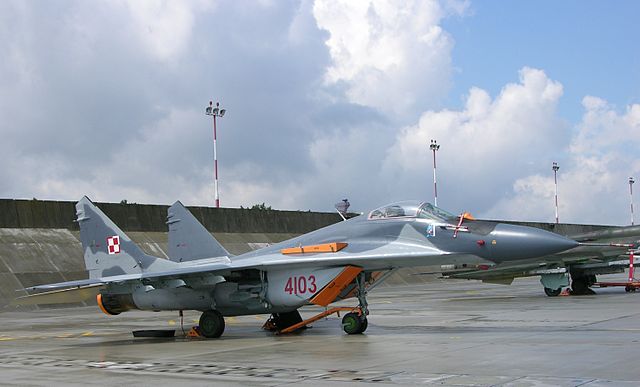
MIG-29 Sniper
Upgrade planned for Romanian Air Force, by Israeli firms. The first flight occurred on 5 May 2000. The program was halted along with the retiring of Romanian MiG-29s in 2003.
MIG-29SMT (“9-17”)
MiG-29 SMT is shown at the Paris airshow in June 1997, Russian Aircraft Corporation MiG (RAC MiG) revealed an extensive upgrade available for aircraft of the above types. MiG-29 SMT is an improved version of the MiG-29 Fulcrum fighter aircraft (models 9-12 to 9-13).
The most extensive modification is to increase internal fuel capacity by 960kg (2,1161b), or about 1,182 liters (260gal), by eliminating the auxiliary inlet system in the centroplan and adding a conformal large spine as on the 9-13. MiG-29 SMT containing enhancements intended for the MiG-29M variant. This provides a maximum flight range of 2,100 km on internal fuel.
Further elements in the upgrade are avionic. The cockpit instrument panel is replaced by a new one with two large multifunction color displays, each 18cm high by 15cm wide (7 x bin), together with two smaller displays plus standby miniature instruments in the center. A further upgrade is to add a ground-mapping mode to the N019M Topaz radar, with a resolution better than 15m (49ft). The MiG-29 Fulcrum A was not designed for an advanced air-to-ground capability, this is substantially improved by the SMT upgrade.
Thu new digital avionics are linked into an STD-1553B bus, together with improved HOTAS (hands-on throttle and stick) controls. The modernized aircraft is equipped with high-precision air-to-air and air-to-surface weapons to deliver high combat efficiency against aerial, ground, and sea-based targets. The upgraded Zhuk-ME radar provides similar features to the MiG-29M. The power plant is upgraded RD-33 ser.3 engines with afterburning thrust rated at 8,300 kgf (81.4 kN) each. The weapons load was increased to 4,500 kg on six underwings and one ventral hardpoint, with similar weapon choices as for later model the MiG-29M. To improve aerial combat capabilities, the Russian Air Force intends to upgrade up to 150 MiG-29 fighters to MiG-29 SMT standard. The upgraded aircraft can also accommodate non-Russian origin avionics and weapons.
MIG-29SMT is armed with two R-27ER1(R1), two R-27ET1(T1), and six RVV-AE medium-range air-to-air missiles; six R-73E short-range air-to-air missiles; four KAB-500Kr / KAB-500L guided bombs; and a 30mm Gsh-301 built-in air gun. The aircraft also carries two Kh-29TE, two Kh-29L, and four Kh-25ML air-to-surface missiles; two Kh-31A anti-ship missiles; and two Kh-31P anti-radar missiles.
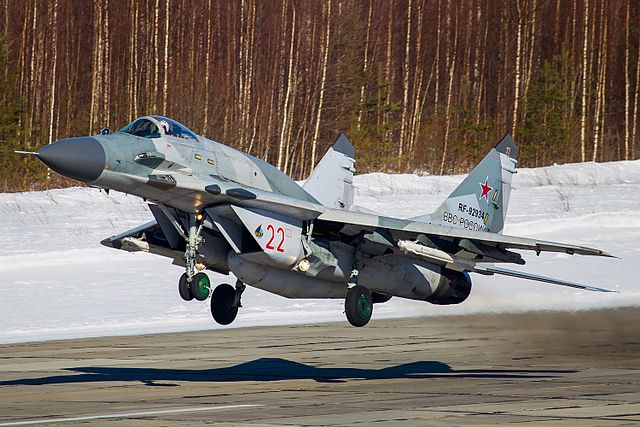
MIG-29BM
The MiG-29BM is Belarus modernization of MIG-29 and can be compared to Russian MIG-29SMT. Designation MIG-29BM is probably short for Belarusian Modernised, or possibly Bolyshaya Modernizaciya – meaning large or better modernization. This modernization is an upgrade to the MiG-29 conducted by the ARZ-558 aircraft repair plant in Baranovichi, Belarus. The basic MiG-29 has only the capability of air-to-ground with unguided rockets and free-fall iron bombs. The MiG-29BM is a multirole variant of the MiG-29 fighter.
Basic MiG-29 could use only medium-range missiles R-27R and R-27T, as well as close-range missiles R-73 and R -60M. MIG-29BM is supplemented with additional air-to-air medium-range missiles RVV-AE, R-27ER, and R-27ET. Also, armament is supplemented with precision-guided weapons for killing ground (maritime) targets. Among them are missiles KH-29T (TD), KH-29L, KH-25ML, KH-31P, and KH-31A, as well as corrected bombs KAB-500Kr and KAB-500L.
Modernized radar N019P of this airplane provides for observation of the earth and water surface with the detection of single and group, pinpoint and prolonged ground and water-surface radio-contrast targets, the issue of coordinates of discovered targets for the formation of target indication, and use of new types of guided weapons including air-to-air missiles RVV-AE and anti-ship missiles KH-31A.
The capabilities of the navigation system of the fighter are broadened significantly. The new navigation system N-911 includes a navigation computer, a receiver of satellite navigation system GLONASS/NAVSTAR, radio technical system of close-range navigation A-323, and navigation and landing system VOR/ILS and DME.
Another significant difference of MiG-29BM from the series-produced MiG-29 is the implementation of an aerial refueling system. An easily dismantled refueling rod that is not retracted in flight is installed in the nose part of the fuselage on the left side. Tests of the MiG-29BM (aircraft “9-11”) were successfully completed by July 2003, and the plant in Baranovichi began the delivery of the first modernized “MiGs” to the Belarus Air Force. By mid-2007 several examples of this aircraft, together with a modernized Su-27UBM which was modernized by the same 558th aircraft repairs plant, were on duty in the Belarusian air fighters fleet.
MIG-29UBT (“9-51T”)
MIG-29UBT is a two-seat trainer that had been developed to replace MIG29-UB or better speaking to provide SMT standard upgrade to MIG-29UB. The MiG-29UB trainer aircraft is designed to perform simple combat training missions, help trainees acquire flying skills and drill actions during simulated failures of airborne equipment. MIG-29UBT go one step further, this model has an installation of the same airborne equipment like that on a one-seater combat fighter and is not below the baseline combat version. This allows the combat trainer to acquire the qualities of the baseline version but endows it with a new capability which is only possible if one more crewmember is present aboard. MIG-29UBT aircraft is not tactical or combat inferior, but in some respect, superior to that of the baseline aircraft.
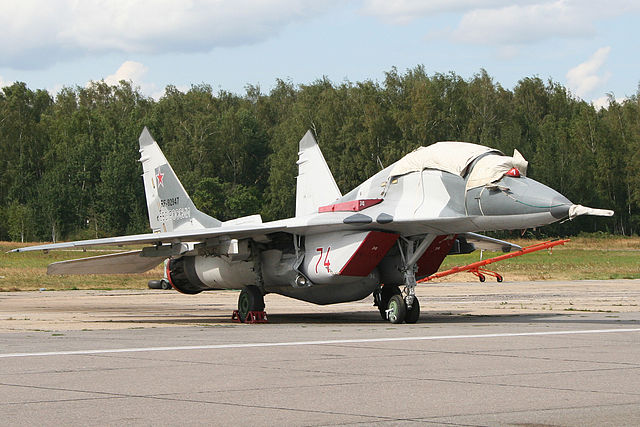
The basic task was the elimination of the shortcomings of the MiG-29UB.
Range and fuel capacity is increased, the flight range of the modernized aircraft reached 2,200 km. A strap-on fuel tank, tried out on the MiG-29SMT combat version and giving a 40% increase in the internal fuel capacity, was used. Also, an in-flight refueling system, also tried out on the MiG-29SMT, was installed and provision was made for new drop tanks.
The other changes involved the replacement of the obsolete avionics and the installation of a new phased array radar. The composition of airborne equipment included multi-pulse Doppler radar station “Osa-2”, as set out in the bow of the fuselage.
The integration of a new digital navigation system with the new radar and a broadened variety of air-to-air and air-to-surface weapons enable the modernized MiG-29UBT to become a real multirole combat aircraft capable of not only intercepting and engaging enemy aircraft while simultaneously attacking four targets but performing the radar mapping of the terrain with location of ground (waterborne) targets, indicating moving targets and supplying the target designation data for launching guided missiles and releasing powerful precision-guided bombs.
Construction of aircraft MiG-29UBT is similar to design single MiG-29SMT fighters. MiG-29UBT fuselage elongated compared to the one fighter at 100 mm. The aircraft MiG-29UBT has two overhead fuel tank, like the MiG-29SMT aircraft. Possible overhead module system refueling in the air with a retractable pole, similar to exhaust the MiG-29SMT.
MIG-29UPG
MIG-29UPG is the Indian customized upgrade of the MIG-29, based on both the SMT upgrade package of MiG-MAPO plus unique India specific items such as a special DRDO developed Electronic Warfare suite. Is very similar to the SMT variant but differs by having a foreign-made avionics suite integrated within it. The weapons suite is the same as the SMT and K/KUB versions. The design is a new modification intended to remove weaknesses of the aircraft like avionics, and weapons systems. This upgrade is for the MiG-29s used by Indian Air Force and
MIG-29UPG is multirole fighter aircraft with modern avionics and can easily engage and defeat current generation aircraft, including the Block 50 F-16.
The MiG-29UPG is capable of mid-air refueling and is powered by an improved RD-33 series 3 turbofan engines that enable the jet to take off almost vertically on full power. The range is increased by 40% to 2,100 km on internal fuel. Introduction of a bigger centreline tank from 1500 liters to 1800 liters tank extending range toward 3,000km
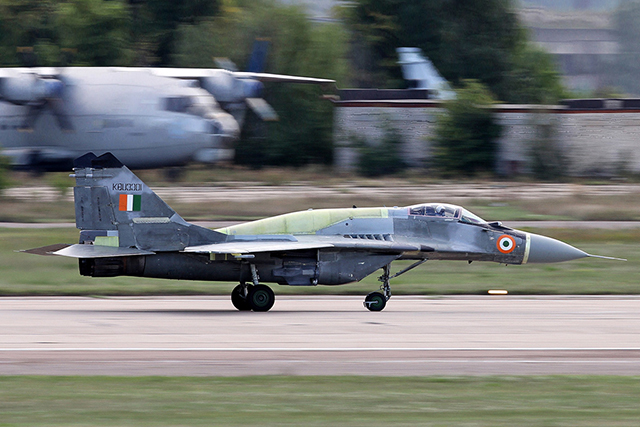
Other features of the upgraded aircraft are a multi-functional display. Improved cockpit ergonomics with enhanced HOTAS design, two large and two smaller monochrome LCD. Air-to-air refueling is solved with a retractable inflight refueling probe, similar to the Malaysian MIG-29N and Russian MIG-29SMT. Weapons load was increased to 4,500 kg on six underwings and one ventral hardpoint similar to the MIG-35 and OLS-UEM IRST sensor with the laser, thermal imaging, and television capabilities give the ability to launch precision-guided munitions. MIG-29UPG is able to use R-77RVV-AE (AA-12 ‘Adder’) air-to-air missile. MIG-29UPG can use the advance subsonic anti-ship missile Kh-35E (AS-20 Kayak).
The standard includes the new Zhuk-M radar, and Phazotron-NIIR’s Zhuk-AME (also known as the FGA50 – AESA radar). The Zhuk-AME radar is expected to give the MiG-29 capabilities of a 4.5 generation fighter jet similar to the F-16 Block 70.
All this makes the MIG-29UPG version one of the “most advanced” MiG-29 variants.
MiG-29SMP / MiG-29UBP
MiG-29SMP is a custom upgrade of MIG-29 for the Peruvian Air Force. This upgrade has the goal to modernize Peruvian MIG-29 similar to SMT standard. The single-seat version is designated SMP, whereas the twin-seat version is designated UBP.
Upgrade provides the digital version of the N019 radar (Zhuk) instead of the N010, avionics from MIG-29SMT. New IRST, glass cockpit, and HOTAS. The SMP standard features an improved ECM suite, new jammers.
Additional fuel tanks are added like on MIG-29SMT, and the installation of an in-flight refueling probe. No major changes in armament, new air-to-ground missiles will not be used. Modernization will be carried out by SEMAN, but the old RD-33 engines will be shipped to Russia for overhauling and refurbishment.
MIG-29MU1
The MiG-29MU1 is the first stage of a Ukrainian upgrade program by the Lviv repair plant. The upgrade brings improved radar. The range of detection of air targets increased up to 29% (up to 100 km in the forward hemisphere and up to 45 km – at the rear). Air-to-air missile R-27ER AAMs, NATO-standard radio, and GPS receiver. Work is now underway on the further improved MiG-29MU2 that brings air-to-ground weapons.
Original and upgraded variants based on the original airframe
This list covers original Soviet variants and upgraded variants based on the original airframe for second-generation variants with modified airframe visit page MIG-33.
List of Mikoyan MiG-29 operators

Algeria

Azerbaijan

Bangladesh

Belarus

Bulgaria

Cuba

Eritrea

India

Iran

Kazakhstan

Myanmar

North Korea

Peru

Poland

Russia

Serbia

Slovakia

Sudan

Syria

Turkmenistan

Ukraine

United States

Uzbekistan

Yemen
List of former operators – Mikoyan MiG-29

Czechoslovakia

Czech Republic

East Germany

Germany

Hungary

Iraq

Israel

Malaysia

Moldova

Romania

Soviet Union

Yugoslavia

